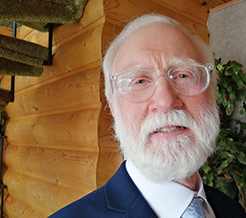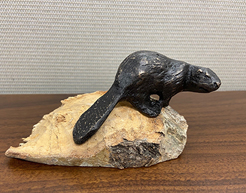NOTICE: Job action by the Canadian Union of Postal Workers continues. Delays in mail delivery are possible. Contact us by email or phone if you need assistance.
Member Profile
June 20th, 2022
 Jack Jensen, P.Eng.
Jack Jensen, P.Eng.
I grew up on a mixed farm with my five brothers. There was an age gap, so I was the middle son of the younger three brothers. Much of the farm income was derived from shipping cream, so there was always lots of work with milking, haying and barn cleaning.
I had good marks in all subjects but I felt there were more job opportunities in math-related fields.
I went into civil engineering, what I would consider the most generalized of the engineering specialties.
I began my studies just as the transition started away from slide rules and towards hand calculators and before the era of personal computers. I remember my first-year physics professor, Dr. Katz, mention that he had seen demonstrations of hand calculators and they would soon be available. Professors had to alter how they wrote examinations to account for the advent of hand calculators. The quality of instruction was high. I remember a hydraulics course where the regular professor had to get a substitute instructor for a class and it turned out to be Professor C. D. Smith. Professor Smith found that the day’s lesson was on calculating flow over weirs, so, without any notes or preparation time, he proceeded to develop the weir flow equations from first principles, which I thought was pretty impressive.
My first job was as a Resident Engineer with the Saskatchewan Department of Highways and Transportation. My projects included the paving across the recently completed Nipawin Bridge. In 1975, I married Linda, a dietetics graduate who had an intern position at Vancouver General Hospital. Within a week of our arrival, I was hired by H. A. Simons International, which at the time was the largest consulting engineering company in Canada with over 1,000 employees. My projects included the layout of large-diameter fibreglass pipes for a pulp mill being built in Longview, Wash. and site work and railway yard layout for a pulp mill in Kwidzyn, Poland. After Linda’s internship period was completed, we returned to Prince Albert and I accepted a position with the Prince Albert engineering department, where I worked for the next 29 years.
Being or becoming a professional engineer was a stipulation for accepting the position with the Prince Albert engineering department. My application was submitted and approved in 1976, within months of our return to Prince Albert.
Prince Albert was emerging from decades of economic stagnation because of the La Colle Falls energy project debacle which removed the city’s ability to borrow money for development. As such, most streets were gravel, arterials had strip pavement with no curbs or sidewalks and there was a backlog of underground maintenance. It was a great experience to be part of the design and supervision of needed capital works and operational maintenance. It was a small engineering department, so things like subdivision design and surface work contracts were handled in-house, and specialty work like water treatment plant upgrades were contracted to consultants.
I had several mentors including Pat Nieman, the Assistant City Engineer, and Tom Hall, the SaskPower District Engineer. Both were very knowledgeable and were willing to impart their wisdom and experience to assist a junior engineer. Mentorship also came from people who had gained valuable experience and knowledge from working in the field. They also knew what problems they faced. By developing a rapport and friendship with the sewer and water crews, we were able to work together to solve problems and effect change that they were unable to do on their own. For example, there had been a practice from earlier times to connect sanitary and storm sewers together to divert sanitary sewage away from downstream work on the sanitary sewer. This can lead to inadvertent sanitary sewage discharge if downstream sanitary sewers get plugged. I was made aware of these interconnections and plugged them and purchased proper pumping equipment for dealing with the problem.
There was a problem with the collapsing of old brick manholes. Over time, sewer gas corroded the mortar and the interior brick edges to the extent that each exposed brick was chisel-shaped. While attending a public works conference in Saskatoon, I struck up a conversation with a contractor who applied shotcrete in mine shafts. I asked if he had ever worked in a space as restrictive as a manhole. He had not, but I arranged for a demonstration project, which would appear to be the first shotcrete-rehabilitated manhole in North America. Over time, 241 manholes were shotcreted in Prince Albert at approximately two-thirds of the cost of replacement, with little disruption to the public and with zero pavement repair costs. The fledgling shotcrete company went on to shotcrete brick and concrete block manholes throughout the Prairie provinces.
I enjoy painting, drawing, cartooning and sculpting. I am a co-founder and active member of a regional artist group called Kyla Art Group, which is planning its 45th annual fall art exhibition and sale. I have made five life-size or larger bronze sculptures. I have also made small bronze sculptures – such as the bronze beaver paperweights that have been presented annually to the APEGS incoming president since 1990 when I presented one to President Dennis Paddock.
I also like making shallow-relief cast paper sculptures. In 2010, I was Team Captain of Saskatchewan’s snow sculpting team at Winterlude, the National Capital Commission’s winter festival in Gatineau, Que. In 2008, I was one of two Saskatchewan artists at The Encampment, an outdoor presentation in illuminated tents set up in Major’s Hill Park, Ottawa. The exhibition featured works depicting the current and historic stories of intellectually disabled people within the society. The wide variety of work was created by artists from across Canada including those with intellectual disabilities.
Another creative outlet is the creation of cartoons. I have created over 400 cartoons and have had two solo cartoon exhibitions. I have also been part of international cartoon exhibitions in Germany and Croatia.
When our children were growing up they became involved in acting and singing, so Linda and I joined them on stage in many community and semi-professional musicals, plays and fundraising events.
For the past several years, I have helped refugees learn English and navigate “the system.” I am amazed by the resilience that they demonstrate as they learn a new language, look for new employment prospects and adapt to new customs in a new country far from all that is familiar. Their positive attitude and generosity has touched me greatly.

Jack Jensen has sculpted the small bronze beaver paperweights given annually to the incoming APEGS president since the early 1990s.